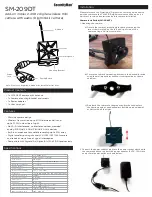
7
competent service engineer. It should not be put back into service
until faults are cured and the oven can be shown to pass the
microwave leakage test.
Note: Industrial ovens may well operate at frequencies outside the
frequency range of the TEK500 (2450 ± 25MHz). Always
check before use.
3.4 Microwave Oven Output Power Test
After the microwave leakage test is found to give a satisfactory
result, the following procedure can be used as a simple functional
test to assess the microwave heating power of the oven.
This functional test should be carried out with the microwave oven
connected to its rated power source.
Fill the 1L beaker supplied with 1L ± 5mL (1000g ± 5g) of water
having a temperature of 10°C ± 1°C.
Use the thermometer (supplied) to accurately measure the initial
temperature of the water.
Record the actual water volume and the initial temperature.
Place the beaker in the centre of the lowest shelf in the oven.
DO
NOT
leave the thermometer in the beaker when it is placed in the
oven.
The oven should then be operated at its maximum microwave
power setting for 90 seconds.
Combination microwave ovens
must
be set to use microwave
power
only
. All other means of heating must be turned off.
8
Note: The heating time is not critical, but must be recorded accurately.
For an oven with an imprecise clockwork timer, use a stopwatch
or wristwatch with a second-hand to establish the duration of
the test.
Immediately after the 90 seconds microwave heating episode, open
the door, give the contents of the beaker a very brief stir using the
thermometer, then measure the final temperature of the water.
Determine the rise in temperature from:
Temperature rise = Final temperature – Initial temperature
The microwave heating power of the oven can be estimated from the
following formula:
Microwave heating power (Watts) = 4190 x Temperature rise
Heating time (seconds)
Note: The above formula is simplified for convenience. The result
should be rounded off to the nearest 50W.
At the end of testing, switch
OFF
the TEK500 before returning it to its
carry case.
3.5 Output Power Testing Considerations
It is important that the quantity of water, temperature rise and heating
time are all recorded accurately, to reduce any errors.
However, experience shows that many ovens will appear to under-
perform.
Results may indicate a heating performance as low as 60% of the
“declared” performance that has been marked on the oven by the
manufacturer.
9
Where an oven appears to under-perform when assessed using
the simplified formula, the full test procedure can be employed, as
given in BS EN 60705 (Household microwave ovens – Methods for
measuring performance).
A number of factors can contribute to this low reading, some of
which will be influenced by the construction and physical size of the
oven, as follows:
Container is not large enough in area to pick up the output of
the magnetron effectively
Water volume is too small
Error in temperature measurements
Error in measurement of true heating time, especially on ovens
with a clockwork timer
Error in allowance for the magnetron filament heating-up time
Thermal capacity of the container used during test is not taken
into account
Rating declared by manufacturer is permitted to vary by ± 15%
(± 120W on an 800W oven) and may present an optimistic
figure
Rating declared by manufacturer may not have been rounded
down to nearest 50 Watts
Magnetron has degraded over its working life
Note that industrial and commercial microwave ovens fall into a
separate category.
While the TEK500 itself is suitable for testing the level of
microwave leakage around door seals etc., the assessment of
microwave oven heating performance is beyond the scope of the
TEK500 thermometer and beaker kit.
10
Such industrial and commercial microwave ovens typically will be
physically larger and more powerful than household microwave
ovens.
Industrial microwave ovens are covered by a separate standard,
which should be consulted if applicable:
BS EN 61307 - Industrial microwave heating installations – Test
methods for the determination of power output.
Information should be sought from the oven manufacturer if there is
any difficulty in assessing the heating performance of industrial or
commercial microwave ovens.
4. MAINTENANCE
4.1 Battery Replacement
The battery compartment is underneath the unit.
Undo the screw securing the battery cover and lift off the battery
cover.
Remove the old battery and replace with a new 9V battery (IEC
6LR61, NEDA 1604A), observing correct polarity.
Replace the battery cover and secure with the screw.
4.2 Calibration
To maintain the integrity of measurements made using your
instrument, Martindale Electric recommends that it is returned
at least once a year to an approved Calibration Laboratory for
recalibration and certification.






















